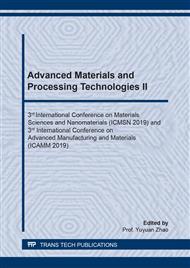p.135
p.143
p.151
p.159
p.165
p.175
p.181
p.189
p.195
Mathematical Simulation and Physical Modeling of Self-Source Magnetization by Liquid Electrolyte Flow
Abstract:
With the increasing requirements for steel quality, the refining conditions are increasing strict. The high-speed movement of molten steel under mechanical or pneumatic agitation can uniform the temperature and composition, and accelerate the collision of the inclusions to eliminate. However, the electromagnetic field has an important influence on the removal of inclusions in steel and the corrosion of refractory materials. The magnetic phenomenon caused by the movement of molten steel needs to be explored. Considering the complexity of high temperature thermal simulation, this work adopted the physical modeling combined with mathematical simulation method, saturated sodium chloride solution was selected to simulate molten steel as a liquid electrolyte, the magnetic phenomenon caused by solution motion was tested and analyzed, and mathematical model of solution motion magnetization was based on discharge mechanism and magnetic vector potential superposition principle, then the variation law of spatial magnetic field generated by liquid electrolyte flow was discussed. The results show that the simulation results agree with that of the physical modeling, and the mathematical model is promising for prediction of the magnetic field generated by liquid electrolyte flow. Under a constant flow speed of 2000 r/min, a magnetic field with magnetic flux density up to 0.15 Gs was produced, which has a significant effect on the refractory corrosion and removal of impurities in the molten steel.
Info:
Periodical:
Pages:
165-172
Citation:
Online since:
March 2020
Authors:
Price:
Сopyright:
© 2020 Trans Tech Publications Ltd. All Rights Reserved
Share:
Citation:


